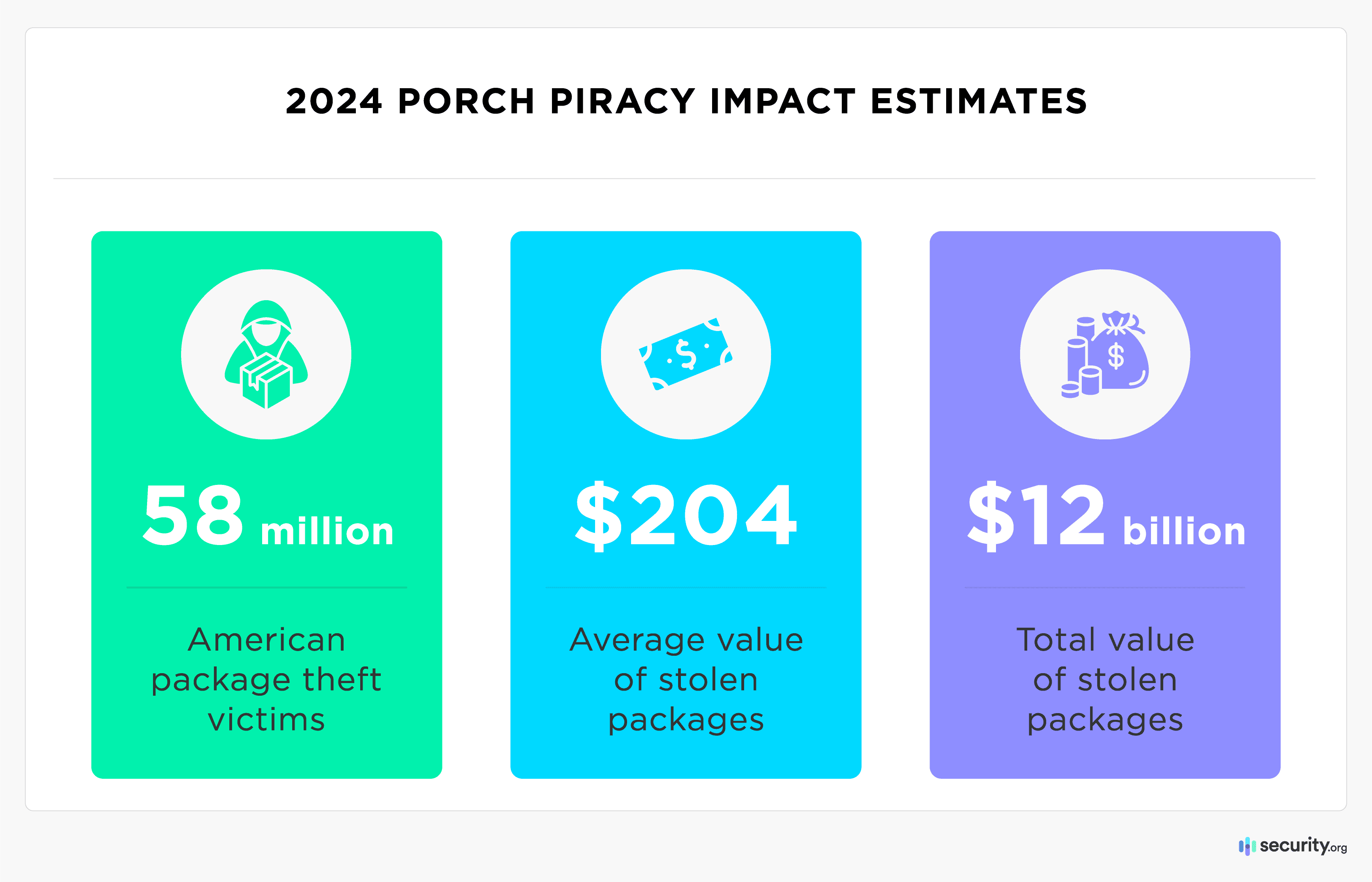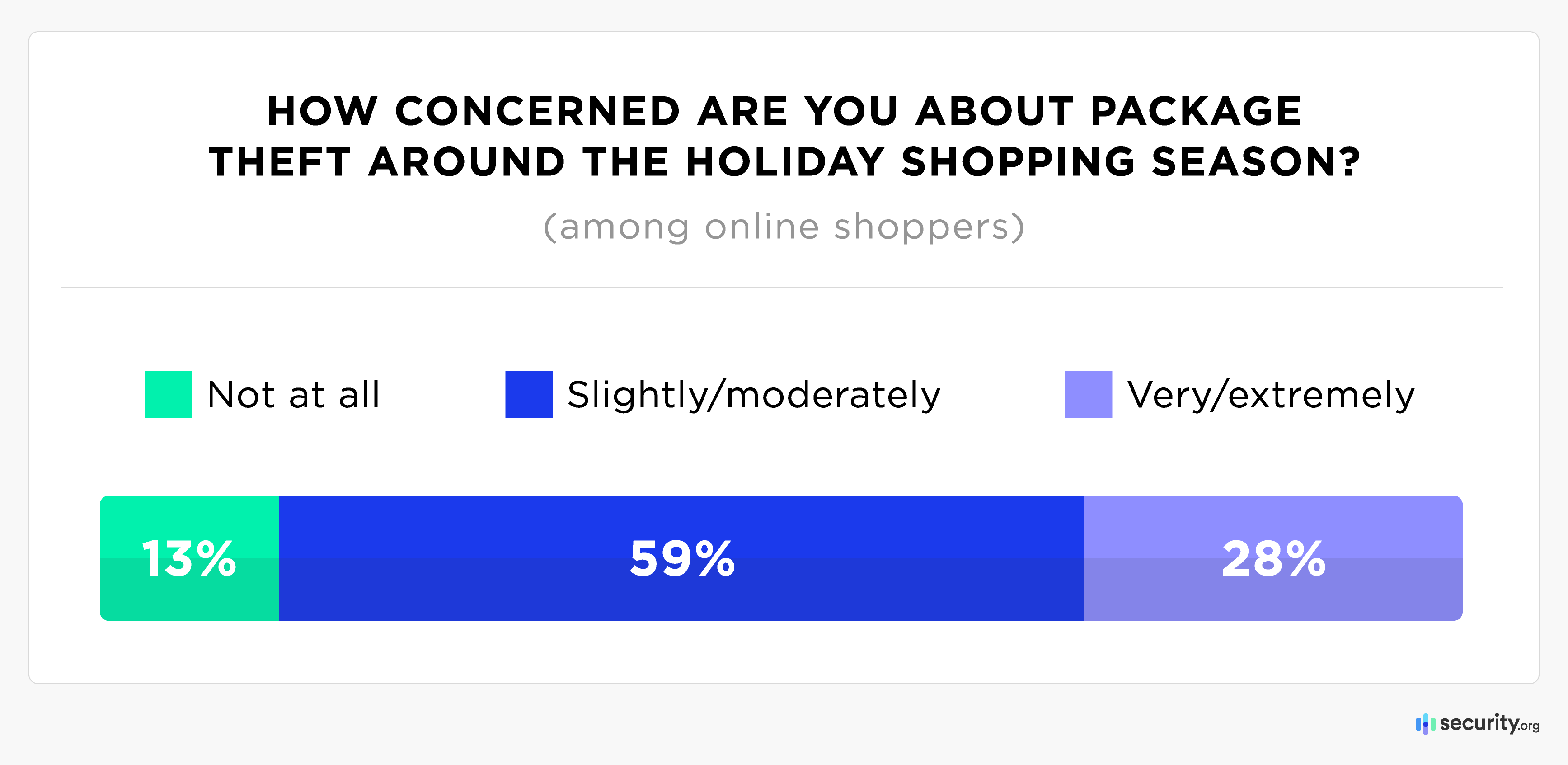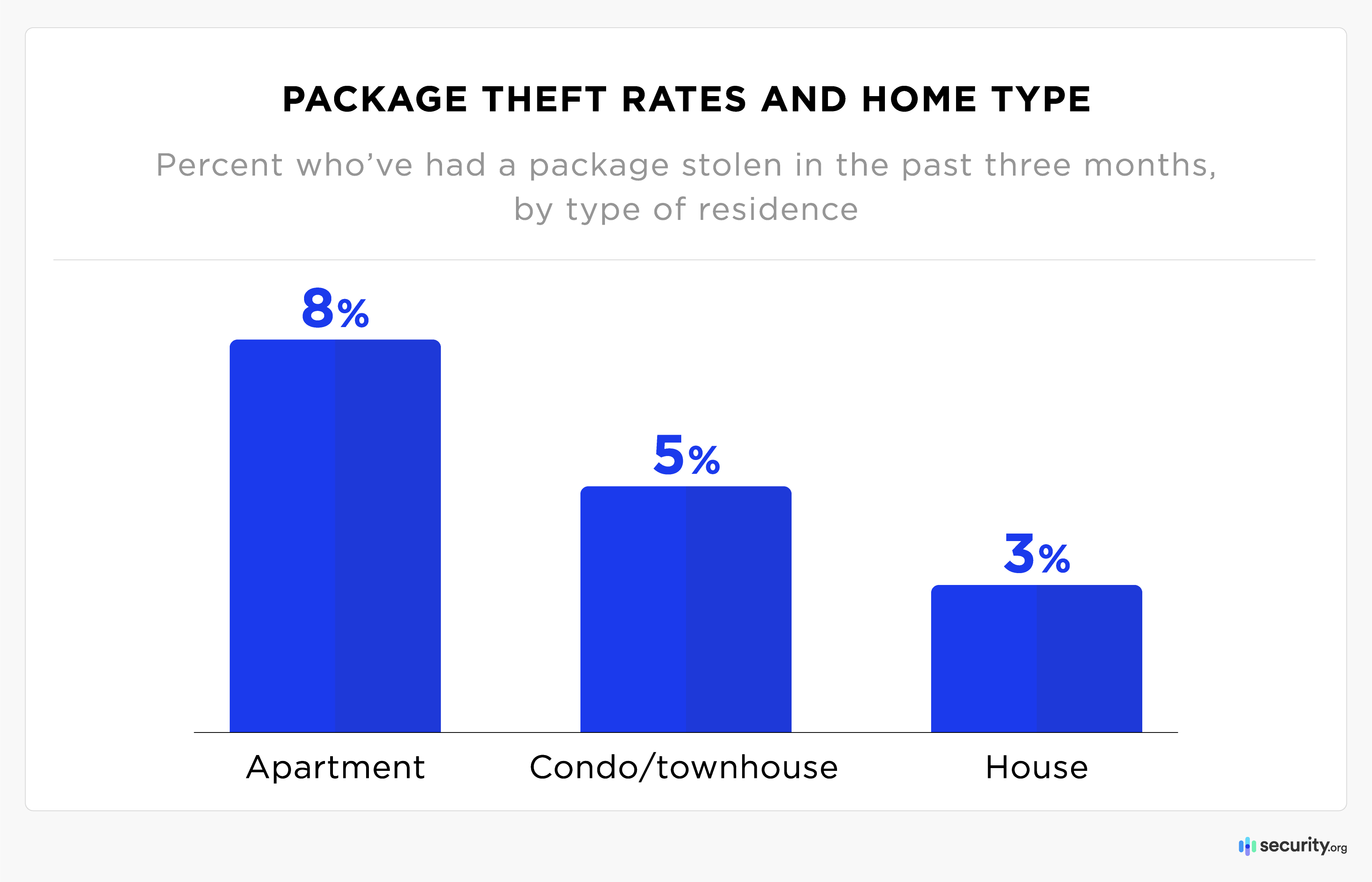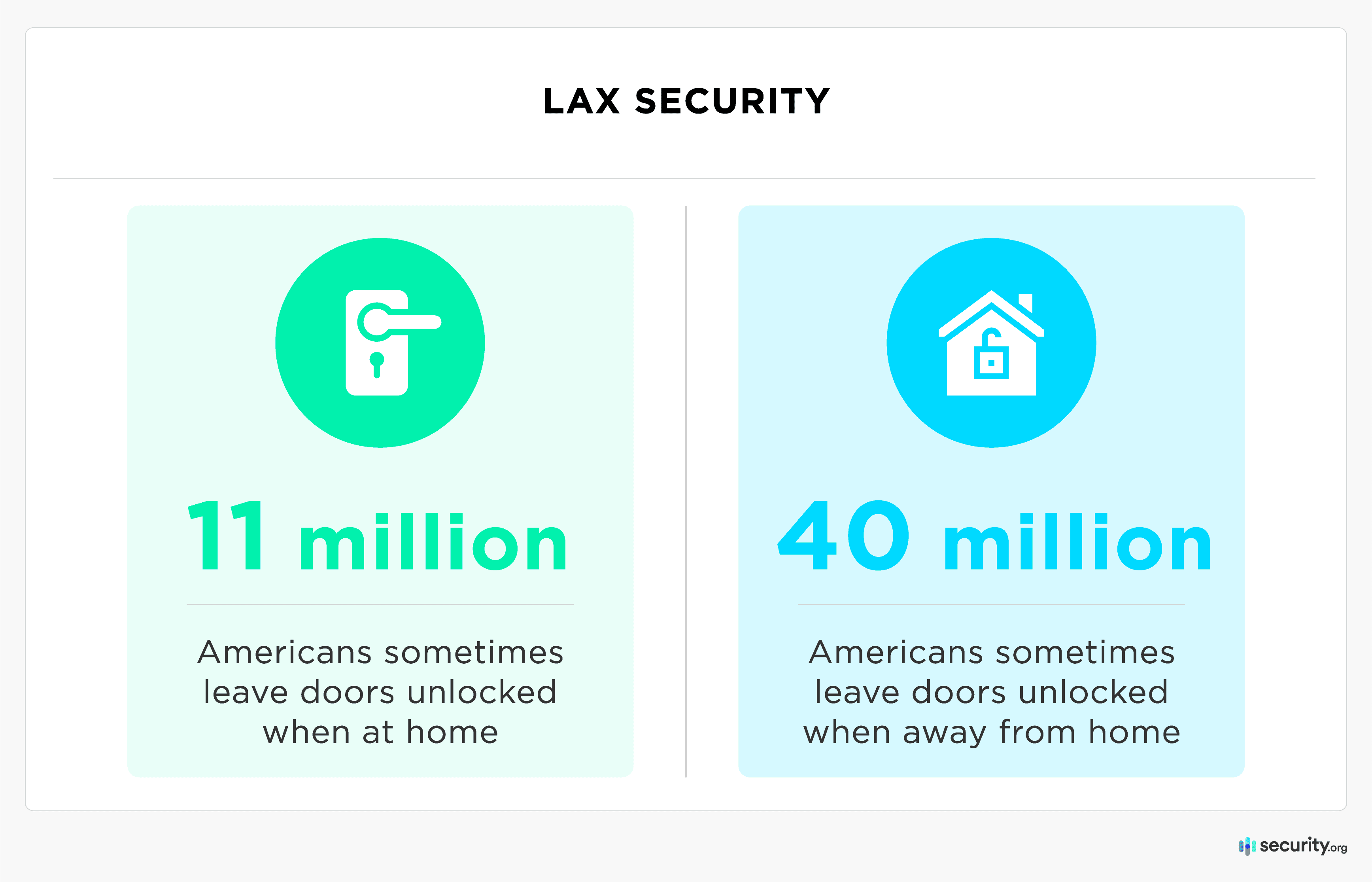2024 Package Theft Annual Report and Statistics
Porch pirates stole at least 58 million packages valued at $12 billion over the past year.
Online purchases generate about 22 billion packages each year, more than 60 for every person! However, not all reach their intended destination. Package thieves – known colloquially as “porch pirates” – steal many deliveries right from our doorsteps and yards.
Though stricter laws and security precautions offer some consumer protections, criminals still grab millions of boxes worth billions of dollars, disrupting lives and festive gift-giving occasions like Christmas and Hanukkah.
Security.org’s 2024 package theft assessment is the most comprehensive report on the topic to date, designed to better diagnose and combat this problem. We surveyed more than 11,000 adults from all 50 states to identify the breadth of the issue, the most vulnerable locations, and the most popular methods for battling the pirates as the holiday shopping season kicks off.
Key Findings:
- Porch pirates stole $12 billion in packages in the past year, and as many as 58 million Americans have become victims in the last 12 months.
- Kentucky, North Dakota, Nebraska, Iowa, and Alaska had the highest rates of recent package thefts.
- One in four Americans have been victimized by porch pirates at some point in their lives, and people of color are twice as likely to have a package stolen as White adults.
- Nine in 10 Americans are worried about stolen holiday packages, and more than a quarter are “very” or “extremely” concerned.
- Apartment dwellers experience package theft at double the rate of those who live in homes.
- 14 percent of Americans take no precautions to prevent package theft, and more than 40M people admit to leaving their exterior doors unlocked while away from home
$12 Billion Worth of Packages Swiped in Past 12 Months
Online shopping is an indispensable convenience that Americans increasingly embrace. E-commerce sales comprise one-sixth of all domestic sales, or $1.2 trillion annually. Related crime is keeping pace.
America’s thriving economy is pushing ahead, and its robust performance is reflected by continued retail growth, mainly driven by surging e-commerce sales. Such encouraging signs are a green light for merchants and a beacon for greedy porch pirates. Our survey found that nine out of ten consumers shop online at least once per month, and half do so weekly. That much activity generates a treasure trove of parcels and millions of possible victims.
Our research revealed that one-quarter of American adults have had a package stolen, and four percent (14 million people) suffered a theft within the last three months. The average value of each stolen parcel was $204, meaning nearly $3 billion in e-commerce merchandise was swiped over this past summer.
Those findings project staggering national theft numbers for the year—which could be even higher, given the elevated shipping volumes of the holidays and incidences of multi-package heists.
Americans worry about pirates stealing holiday gifts
In the weeks leading up to Hanukkah and Christmas, delivery services will leave billions of parcels outside homes as online gift shopping revs up for the holidays.
All those gifts left on all those porches leave Americans anxious about possible theft, which can dampen holiday cheer. Eighty-seven percent of online shoppers are concerned about having a package stolen around the holiday season, with 28 percent expressing they are “very” or “extremely” worried. That number jumps to 38 percent among people of color.
These concerns are justified, as one-half of those who’ve experienced package theft have had a gift intended for someone else stolen. The scale of package thievery is a nationwide problem, but some regions are more affected than others. Check out the state-by-state findings below to gauge your relative risk.
Which States Are Worst For Package Theft?
Package theft tends to be a crime of opportunity rather than a reflection of localized lawlessness. Where parcels are numerous, unguarded, or exposed, incidents of piracy are likely to be higher regardless of overall crime rates.
Accordingly, states with the most package theft don’t mirror those with the highest property crime rates. The unique nature of the crime also underscores the need for parcel precautions even in otherwise safe areas.
Nationally, four percent of adults had a package stolen within the last three months. That rate was around three times higher in the five states with the most porch piracy.
| States with the most package theft | Percent who had a package stolen in the previous three months | States with the least package theft | Percent who had a package stolen in the last three months |
|---|---|---|---|
| Kentucky | 12% | Connecticut | 1% |
| North Dakota | 11% | Michigan | 1% |
| Nebraska | 10% | Utah | 1% |
| Iowa | 10% | Georgia | 2% |
| Alaska | 10% | New Jersey | 2% |
The five most affected states are all largely rural, and four of the five states with the lowest package theft rates are among the 20 most densely populated states. Each state experienced porch piracy at less than half the national rate. Regionally, the West and the Northeast have the most packages stolen, while the Midwest proves the safest section for parcels.
States with the highest median value of recently stolen packages
| State | Median value |
|---|---|
| Indiana | $250 |
| Mississippi | $250 |
| Idaho | $225 |
| Montana | $200 |
| Delaware | $200 |
The median value of stolen packages also varied widely by state, from a high of $250 in Indiana to a low of $25 in Oregon. High-value thefts also occurred more frequently in less populous states. Perhaps because savvy pirates don’t steal mindlessly, they learn to identify packages that are more likely to contain valuable portable contents (such as electronics, appliances, or jewelry). Operating in isolated/remote areas may provide time for thieves to be more discerning.
Additional Risk Factors for Package Theft
Risk factors for porch piracy aren’t solely geographical; we found they may also relate to household type, shopping habits, and even ethnicity.
Criminals seem to target certain residential building types more than others—homes with more occupants tend to experience higher theft rates. This may be because densely populated dwellings offer more potential targets and allow criminals to blend in more easily. Another factor could be that single-family homes are more challenging to approach without being noticed and are more likely to have security measures in place.
Frequent online shoppers are more likely to fall prey to pirates. Consumers who place several online orders weekly were twice as likely to be victimized as those who place orders only a few times per year.
Package theft rates and online shopping frequency
| How often do you shop online? | Percent who had a package stolen in the last three months |
|---|---|
| A few times per week | 6% |
| A few times per month | 4% |
| A few times per year | 3% |
Our survey also found that people of color (those who identified as Asian, Black, mixed, or other) experienced package theft more than twice as often as white people (seven percent versus three percent). Since porch pirates rarely interact with victims, this difference likely reflects the higher number of non-white residents in dense urban areas rather than bias in targeting.
With 99 percent of Americans shopping online at least a few times per year, we’re all potential victims of porch pirates, so how can we best safeguard our shipments?
Protecting Your Packages and Presents from Porch Pirates
As package theft is a national issue many people worry about, 86 percent of Americans say they employ at least one method to deter porch piracy, and 55 percent use two or more strategies to fight package theft. These are the most popular approaches:
Most common methods to prevent package theft
| Method | Percent of respondents |
|---|---|
| Schedule shipments for when you are home | 45% |
| Doorbell camera | 38% |
| Shop in-store or online with in-store pickup | 24% |
| Security system | 20% |
| Installed external lights or signs | 18% |
| Have neighbors bring packages inside | 17% |
| Ship packages elsewhere (workplace, access point, etc.) | 14% |
| Have packages delivered to someone else | 8% |
| Leave work during breaks to bring deliveries inside | 6% |
| Grant home access to delivery services (like Amazon Key) | 3% |
| None of these | 14% |
*-Multiple selections allowed
Interestingly, 14 percent of people don’t do anything to defend themselves against package theft. But perhaps even more alarming is the number of Americans who fail to basically secure their homes. Forty-two percent said they sometimes leave doors unlocked at home, and 15 percent admitted doing the same even when they are away. When packages are luring criminals right up to front doors, it’s prudent to ensure that measures are in place to prevent them from venturing further.
One final defense against incurring losses at the hands of porch pirates is to carry financial protection for the theft of precious packages. Check your renter/homeowner policy to determine if you’re covered, or be sure to use credit cards that carry purchase protection online.
Package theft prevention isn’t complicated, and generally, our advice falls into three categories:
- Secure your home: Modern technology offers myriad ways to secure and monitor one’s home and surroundings. Internet-enabled doorbell cameras allow you to keep an eye on the porch even when away from home. Security systems can offer the same service for every angle of your house (while supplying additional measures to keep thieves outside the home). Providing well-lit delivery areas is an excellent deterrent that becomes more important during the early nights of the holiday season. After installing such measures, announce their presence clearly – it’s better to scare off a thief than catch them after the fact.
- Avoid prolonged exposure: The longer your packages sit unprotected, the more likely someone will snatch them. Having friendly hands ready to receive parcels is the best way to keep shipments safe. Take advantage of online scheduling options to arrange delivery times when you will be home, when you can take a break and get home, or when someone else can bring your package inside. Most delivery apps provide real-time tracking so you can follow your packages and perfectly time their collection. For added assurance, you can require a signature so the package won’t be left unattended if no one’s around. Instead of leaving your packages unattended in plain sight, ask delivery drivers to drop them in a more private or protected part of your property. In your delivery instructions, tell drivers to place packages in discrete or monitored areas where they won’t be visible from the street. Consider putting a package lockbox on your property, accessible only to you and delivery drivers. If you live in an apartment building, specify that packages should be left with door attendants or in protected mailrooms rather than entryways or sidewalks.
- Designate an alternate delivery location: Packages waiting on the doorstep are convenient and fun, yet far from the safest option. Ensure parcels are left in trusted hands or under lock and key whenever possible. Choosing delivery to a work/business address allows staff to accept and protect parcels. If you have friends or family who are always at home, you might route packages to them. Amazon and other services also offer delivery lockers in prominent public locations so you can grab packages when your schedule allows. Alternatively, you can choose a “hold for pickup” option if the delivery service has a hub near you. Finally, you can forgo delivery altogether and shop in a brick-and-mortar retailer – don’t worry, you can still order online and have the package waiting for you (perhaps even brought to your car).
What to Do if You’re A Victim of Package Theft
No matter how many precautions one takes with packages, pirates can always strike (especially when cleverly disguised as Amazon drivers or squirrels). Quickly confirming and reporting the crime is essential, especially if you hope to replace a gift before the holidays. Here are some steps to follow if you believe a parcel is missing:
- Verify delivery: Double-check to ensure a package was delivered before jumping to conclusions. Track the package online, look for confirmation messages, or check your door for notices to ensure the parcel isn’t delayed or awaiting a signature. Ask family, friends, or neighbors to see if they collected the package on your behalf. If you have security cameras, review the video to determine if you caught a thief in the act. If you’re confident a package was stolen, preserve any evidence and start reaching out to retailers and authorities.
- Notify sellers and shippers: Contacting the seller is the most prudent first step, as they may quickly send a new package. Many retailers will replace purchases with little hassle. Still, some may require the filing of claims, submission of police reports, or refer you to the shipper instead. Many e-commerce sites provide simple links to expedite the process, but to save time and frustration, assemble all relevant information (like order number, tracking details, or delivery time) before initiating your report.
- Contact the authorities: Catching porch pirates without visual evidence is challenging, but it’s always important to report their activity. Filing police reports provides documentation that can expedite claims and provide valuable data points to help cops stop crimes and possibly protect your neighbors or next delivery. Increased reporting of package thefts also encourages police and politicians to consider the issue more seriously. This year, Pennsylvania, Florida, and Washington, -DC, enacted stricter legislation to prosecute pirates. They join nine other states (Arkansas, Georgia, Kentucky, Michigan, Missouri, New Jersey, Oklahoma, Tennessee, and Texas) that label porch pirates as felons and three others (California, Minnesota, and New York) considering similar measures. Some jurisdictions are even becoming proactive and setting up sting operations to capture thieves.
- Confirm your coverage: If the retailer or shipper resists prompt replacement or reimbursement, check with your home insurance company to see if you’re protected against theft (and whether the package value exceeds your deductible). Also, contact your credit card company to halt payment or activate purchase protection.
Unfortunately, only one-quarter of porch pirate victims contact the police, but 91 percent report the crime somewhere. Most reach out to the retailer and delivery companies.
Where did victims report their most recent package thefts?
| Location | Percent |
|---|---|
| The retailer where the item was purchased | 57% |
| The delivery company (such as UPS, USPS, or FedEx) | 57% |
| Local law enforcement | 27% |
| Online neighborhood group or message board | 20% |
| Doorbell camera providers, such as Amazon Ring | 17% |
| Social media | 16% |
| None of the above | 9% |
Note: Multiple selections allowed
Victims are more likely to report stolen packages for pricier deliveries: the median value of a lost parcel reported to the authorities was $195, compared to $50 for those never filed with the police.
Conclusion
With autumn’s arrival, holiday shopping has already begun. Soon, Black Friday and Cyber Monday will accelerate the nation’s e-commerce frenzy. That excitement may be tempered by a shortened shopping season and looming seaport strike threatening to create a compact, complex commercial season.
The last thing any gift-giver needs is a treasured package stolen before it finds its recipient.
Over 10 million Americans had $2 billion worth of parcels stolen in the last three months alone. Increased holiday activity is sure to accelerate porch piracy and jeopardize year-end festivities.
Cybershoppers should do their best to thwart stealing scrooges by locking their doors, using best delivery practices, and knowing how to handle package theft when it happens.
Our Data
In August 2024, Security.org surveyed 11,163 American adults regarding their personal experiences with online shopping, home security, and package thefts. The poll was conducted online, and the results were weighted to reflect current nationwide demographics accurately. The raw pool of respondents was 53 percent female, 37 percent male, and 10 percent preferred not to identify gender. Participants self-identified ethnicity as 68 percent white, 11 percent black, nine percent Asian, and 11 percent mixed/other, with one percent choosing not to provide racial information. There were at least 100 participants from every state, with 80 residing in the District of Columbia.
Appendix
Check the sortable table below to see which states have the most and least package thefts, where citizens are most worried about porch pirates, and the parts of the country where Americans are most comfortable leaving their doors unlocked.
| State | Percent who had a package stolen last 3 months | Median value of most recent package stolen | Percent who don’t always lock doors when away | Percent highly concerned about holiday package theft |
|---|---|---|---|---|
| Alabama (AL) | 3% | $150 | 12% | 25% |
| Alaska (AK) | 10% | $75 | 19% | 30% |
| Arizona (AZ) | 4% | $72 | 9% | 31% |
| Arkansas (AR) | 4% | $61 | 20% | 21% |
| California (CA) | 6% | $83 | 12% | 35% |
| Colorado (CO) | 3% | $87 | 19% | 31% |
| Connecticut (CT) | 1% | $28 | 17% | 34% |
| Delaware (DE) | 6% | $200 | 15% | 36% |
| Florida (FL) | 3% | $88 | 9% | 25% |
| Georgia (GA) | 2% | $100 | 12% | 30% |
| Hawaii (HI) | 6% | $113 | 13% | 32% |
| Idaho (ID) | 3% | $225 | 12% | 23% |
| Illinois (IL) | 4% | $100 | 15% | 28% |
| Indiana (IN) | 3% | $250 | 14% | 24% |
| Iowa (IA) | 10% | $200 | 18% | 22% |
| Kansas (KS) | 5% | $60 | 21% | 28% |
| Kentucky (KY) | 12% | $78 | 11% | 25% |
| Louisiana (LA) | 4% | $55 | 14% | 34% |
| Maine (ME) | 4% | $75 | 32% | 21% |
| Maryland (MD) | 4% | $35 | 16% | 33% |
| Massachusetts (MA) | 3% | $50 | 18% | 15% |
| Michigan (MI) | 1% | $80 | 18% | 20% |
| Minnesota (MN) | 3% | $50 | 17% | 26% |
| Mississippi (MS) | 4% | $250 | 15% | 41% |
| Missouri (MO) | 3% | $38 | 16% | 26% |
| Montana (MT) | 4% | $200 | 37% | 32% |
| Nebraska (NE) | 10% | $100 | 25% | 30% |
| Nevada (NV) | 7% | $68 | 7% | 33% |
| New Hampshire (NH) | 4% | $95 | 20% | 24% |
| New Jersey (NJ) | 2% | $150 | 10% | 21% |
| New Mexico (NM) | 4% | $86 | 6% | 35% |
| New York (NY) | 6% | $50 | 16% | 32% |
| North Carolina (NC) | 3% | $125 | 13% | 28% |
| North Dakota (ND) | 11% | $63 | 22% | 31% |
| Ohio (OH) | 2% | $123 | 20% | 19% |
| Oklahoma (OK) | 2% | $143 | 9% | 37% |
| Oregon (OR) | 3% | $25 | 20% | 24% |
| Pennsylvania (PA) | 5% | $75 | 17% | 24% |
| Rhode Island (RI) | 5% | $113 | 22% | 30% |
| South Carolina (SC) | 3% | $50 | 16% | 24% |
| South Dakota (SD) | 3% | $163 | 18% | 25% |
| Tennessee (TN) | 2% | $75 | 15% | 27% |
| Texas (TX) | 5% | $100 | 12% | 33% |
| Total national | 4% | $80 | 15% | 28% |
| Utah(UT) | 1% | $75 | 18% | 30% |
| Vermont (VT) | 9% | $113 | 33% | 24% |
| Virginia (VA) | 6% | $65 | 19% | 26% |
| Washington (WA) | 4% | $75 | 11% | 26% |
| Washington, DC (District of Columbia) (DC) | 14% | $200 | 20% | 49% |
| West Virginia (WV) | 7% | $100 | 25% | 26% |
| Wisconsin (WI) | 4% | $45 | 24% | 18% |
| Wyoming (WY) | 4% | $182 | 25% | 25% |







